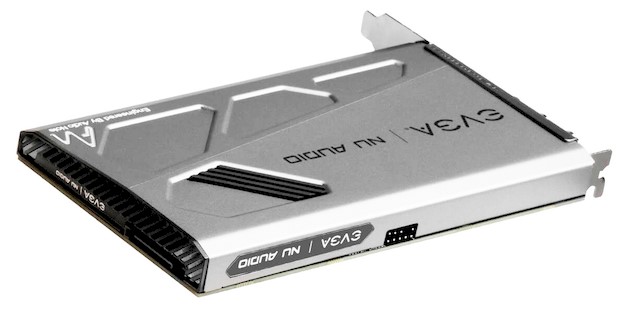EVGA NU Audio Review: Crisp, Clear, Sound For PC Enthusiasts
EVGA NU Audio - Software And Setup
Installing and setting up the EVGA NU Audio card is about as straightforward and easy as can be. The physical installation is simply a matter of plugging the card into an available PCIe x1 slot and attaching power to the rear via a standard SATA connector. If you’d like to attach front-mounted case connectors, there is also a header on the top of the card to accommodate that. Ideally, we wish the front panel audio header was moved to the back of card, because it forces users to drape a cable across their motherboard, but it’s usually a thin, black cable that’s easy enough to hide.
Although EVGA is likely to add features over time and bulk up the driver / software suite, at this time, the entire NU Audio driver pack is a paltry 6.36MB download. Double-click the file, accept the license agreement, and that’s really it. The software installation requires almost no user interaction and the control panel menus are similarly clean and easy to navigate.
The main four control panel screens consist of a volume / level controls for the headphone, speaker, and microphone / line inputs and output, simple equalizer controls with six locations to save presets, RGB lighting controls (for color and effects like pulsating, solid, rainbow, etc.), and a Setup page for localization and choosing your desired input and output filtering defaults, among a couple of other settings.
The 10-band equalizer gives users the ability to tweak frequency levels form 32Hz on up to 16KHz, and to save favorites into six different preset buttons. The look and feel of the actual menus is reminiscent of EVGA’s Precision X1 utility for graphics cards, but obviously the actual options are quite different. This thing ain’t no GPU...
The Lighting menu has only three fields, a drop down to choose your desired lighting effects, another to set the actual color or speed of the effect (the options in the left box will change to match the chosen effect in the drop down), and another for brightness. It is only the EVGA NU Audio badge on the top of the card that is lighted, so regardless of what options are chosen, the actual affect inside a system is relatively subdued.
On the Setup screen, users are given the ability to choose their desired language, select their preferred update scheme, check their card’s firmware, and select a filtering method for the card’s inputs and outputs to tune the audio for a variety of sound settings. The options include things like Natural Tone, Acoustic Sound, and Harmonic Sound (among others), and an explanation for how each filter affects the audio output is given just below the drop down.
Overall there’s very little muss and clutter, and navigating through the entirety of the audio options should be straightforward for even novice users.
Although EVGA is likely to add features over time and bulk up the driver / software suite, at this time, the entire NU Audio driver pack is a paltry 6.36MB download. Double-click the file, accept the license agreement, and that’s really it. The software installation requires almost no user interaction and the control panel menus are similarly clean and easy to navigate.
The main four control panel screens consist of a volume / level controls for the headphone, speaker, and microphone / line inputs and output, simple equalizer controls with six locations to save presets, RGB lighting controls (for color and effects like pulsating, solid, rainbow, etc.), and a Setup page for localization and choosing your desired input and output filtering defaults, among a couple of other settings.
The 10-band equalizer gives users the ability to tweak frequency levels form 32Hz on up to 16KHz, and to save favorites into six different preset buttons. The look and feel of the actual menus is reminiscent of EVGA’s Precision X1 utility for graphics cards, but obviously the actual options are quite different. This thing ain’t no GPU...
The Lighting menu has only three fields, a drop down to choose your desired lighting effects, another to set the actual color or speed of the effect (the options in the left box will change to match the chosen effect in the drop down), and another for brightness. It is only the EVGA NU Audio badge on the top of the card that is lighted, so regardless of what options are chosen, the actual affect inside a system is relatively subdued.
On the Setup screen, users are given the ability to choose their desired language, select their preferred update scheme, check their card’s firmware, and select a filtering method for the card’s inputs and outputs to tune the audio for a variety of sound settings. The options include things like Natural Tone, Acoustic Sound, and Harmonic Sound (among others), and an explanation for how each filter affects the audio output is given just below the drop down.
Overall there’s very little muss and clutter, and navigating through the entirety of the audio options should be straightforward for even novice users.











